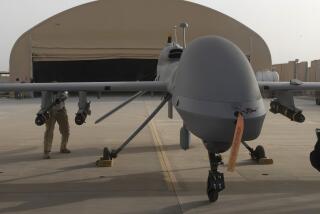Questions Remain About Zarqawi’s Final Minutes
HIBHIB, Iraq — The two bombs fell in the heart of the orchard near this village north of Baghdad a little more than a minute apart. Abu Musab Zarqawi’s last refuge, a whitewashed house in an idyllic rural setting, was obliterated.
On Saturday, three days after Zarqawi was killed, the U.S. military brought a group of reporters to see the slabs of concrete and twisted metal that are all that remain of the house. American troops who had combed through the debris had left the more mundane items: candy wrappers, a child’s shoe, a torn page of a May 2 copy of the Arabic-language edition of Newsweek, and a threadbare leopard-print slip.
Neither the rubble nor the items left behind offered many clues about Zarqawi or the people who died with him. And questions remained about the final minutes of the leader of Al Qaeda in Iraq.
In a briefing with reporters, Army Maj. Gen. William B. Caldwell IV, a U.S. military spokesman, said that two doctors had been brought to Iraq to conduct an autopsy to determine the exact cause of Zarqawi’s death. Results from the examination will be made public within days, Caldwell said.
He also confirmed that a girl between 5 and 7 years old had died in the bombing. Two unidentified women and one man were also killed in addition to Zarqawi and his spiritual advisor, Sheik Abdel Rashid Rahman, Caldwell said. U.S. officials at first had said that Zarqawi and at least five others had died, including a woman and a child, but then changed to say that seven people had died, none of them children.
The military has revised several other details of the bombing and its aftermath.
Caldwell said that early reports after a military operation can sometimes include hazy or contradictory information.
“There is no intention on anybody’s behalf to engage in deception, manipulation or evasion,” he said.
After first reporting that Zarqawi was dead when U.S. troops arrived, U.S. officials also now agree with Iraqis who said that the leader of the terrorist organization died at the site in the presence of U.S. troops.
American commanders in nearby Baqubah said Saturday that local Iraqi police, unaware of the top-secret bombing mission, heard the two blasts and sent officers and an ambulance to the orchard. Stationed less than two miles away, the officers arrived within 10 minutes.
Finding Zarqawi wounded, they put him on a stretcher, according to accounts from Iraqi police and U.S. military officials.
U.S. military officials say that troops who arrived moments later quickly identified Zarqawi and strapped him to the gurney when he began to move.
“He died almost immediately thereafter from the wounds he’d received from this airstrike,” Caldwell said.
U.S. officials denied several news reports that Zarqawi was abused by U.S. troops before he died.
An Iraqi police lieutenant who said he was among the first people at the scene told The Times on Saturday that after Iraqi police had carried Zarqawi to the ambulance on the stretcher, U.S. troops took him off the stretcher and placed him on the ground. One of the Americans tried to question Zarqawi and repeatedly stepped on his chest, causing blood to flow from his mouth and nose, said the lieutenant, who spoke on condition of anonymity.
A man identified only as Mohammed, who said he lived near the Zarqawi hide-out, told Associated Press Television News that he had witnessed Americans beating Zarqawi. “They stomped on his stomach and his chest until he died and blood came out of his nose,” he said.
A U.S. military spokesman said by e-mail Saturday that there was no evidence to support allegations that coalition forces had beaten the insurgent leader.
“Although Zarqawi was mortally wounded, a coalition medic treated him while he lapsed in and out of consciousness,” the spokesman said.
The U.S. military said intelligence specialists had been following the movements of Rahman, Zarqawi’s spiritual advisor, for weeks. When it became clear Wednesday that Rahman was meeting Zarqawi, American commanders ordered the pilot of an F-16 fighter jet that was on a routine mission in the area to drop the two bombs on the house.
How long Zarqawi and the others had lived at the house was unclear, military officials said.
Lt. Col. Thomas Fisher, commander of the 1st Battalion, 68th Armored Cavalry, said the previous owner told American military officials that he had sold the house two months ago. Neighbors said that they saw a family moving in about 10 days ago, but that there had been little traffic to and from the house.
“We go up and down these roads every day,” said Maj. Angel Brito, commander of the battalion’s Charlie Company, which patrols Hibhib. “I was very surprised. There were no clues.”
Brito said he had received several congratulatory calls from local leaders, but for him the celebration was tinged with frustration. Zarqawi “was under my nose the whole time,” he said.
Times staff writer Saif Rasheed in Baghdad contributed to this report.
More to Read
Sign up for Essential California
The most important California stories and recommendations in your inbox every morning.
You may occasionally receive promotional content from the Los Angeles Times.










